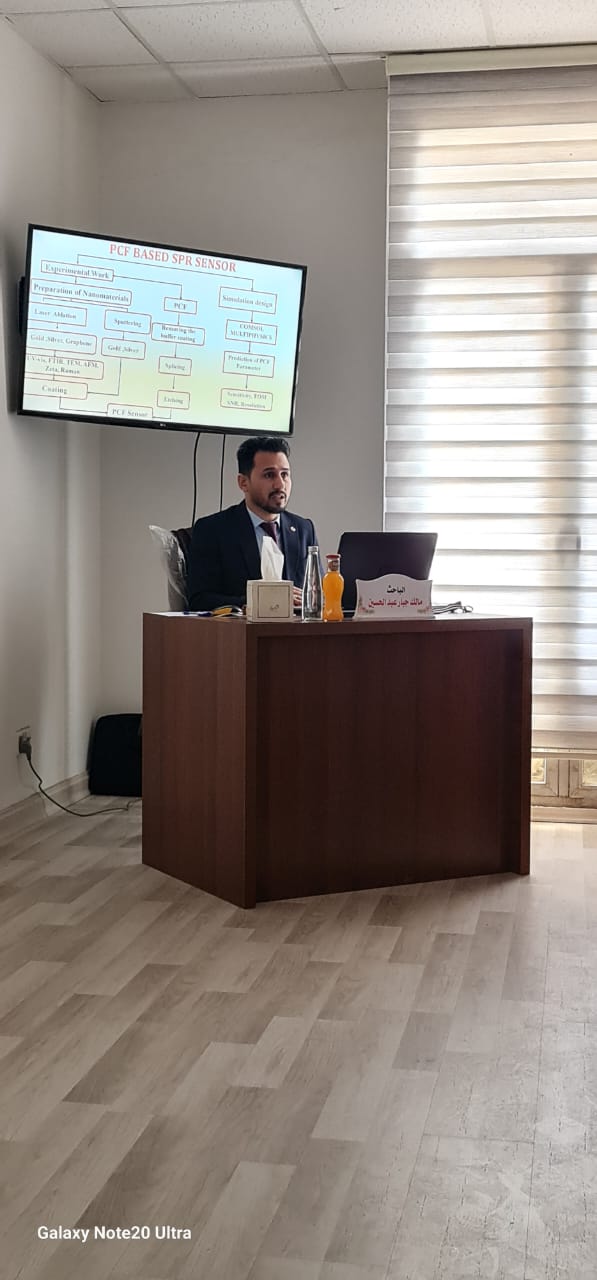Visitors: 33915958 Views
Done By: Laser & Optoelectronic Engineering Department
Post Date: 2023-11-29
Last Browse: 2025-12-25

MODELING, DESIGN AND FABRICATION OF PCF-SPR- BASED NANOPARTICLES FOR Bio-Sensing ABSTRACT Photonic crystal fiber sensors are becoming increasingly important in various sensing applications; biological, chemical, and environmental changes which can be performed by constructing simple and inexpensive elements using PCF. This thesis proposed a PCF-based sensor using the COMSOL Multiphysics 6.1 simulation software finite element method (FEM). The centrepiece of the fiber cladding was removed and coated with various nanolayers such as gold, silver, and graphene. The simulation results of the PCF sensor immersed with glucose dissolved in the blood of refractive index range (1.3476-1.352), exhibited a sensitivity of 2188 nm/RIU and 1931 nm/RIU with resolution were 7x10 -5 RIU and 1x10 -5 RIU for PCF coated with gold and silver nanolayer, while the sensitivity increased to 4377nm/RIU and 3862 nm/RIU with the resolution 3.5x10-5 RIU and 2.5 x10-5 RIU for PCF coated with graphene-Au and graphene-Ag nanolayer respectively. Based on this analysis, The experimental work consists of preparing a PCF sensor and synthesis of gold, silver and graphene nanoparticles by pulsed laser ablation at 532 nm and 1064 nm, which then used to coat PCF. The etching was done after splicing PCF between two equal lengths of single-mode fibres (SMFs). The gold/silver and graphene nanoparticles have been coated with an etched area of PCF using sputtering and dip coating. The ends of SMFs were connected to a 1550 nm laser source and optical spectrum analyser. Then, the sensing area is immersed in the different solutions of glucose and urea to measure the variation concentration. The results showed that the sensitivities for PCF coated with gold and silver NPs by the sputtering method are 1943 nm/RIU, and 1114 nm/RIU with a maximum resolution of 2.51x10-5 RIU for glucose dissolved in water and 1395 nm/RIU,1363 nm/RIU with resolution 2.26x10-5 RIU, for urea dissolved in water. The sensitivity of PCF coated with PVA- gold /silver NPs by dip coating was 1927nm/RIU and 1396 nm/RIU with a maximum resolution of 2.37x10-5 RIU for glucose dissolved in water. It is found that the sensitivity of the PCF sensor increases when adding graphene nanoparticles. The sensitivity reached 2513 nm/RIU for PCF with graphene-Au nanoparticles, and the resolution was 2.48x10-5 RIU for glucose dissolved in water and 1996 nm/RIU for urea dissolved in water. The average sensitivity for the glucose dissolved in blood was also obtained by adding graphene nanoparticles over the gold and silver layers, resulting in a sensitivity of 1314nm/RIU and 1119 nm/RIU with resolution 4.22x10-5 RIU and 2.7x10-5RIU, respectively. The achieved sensitivity values were acceptable compared to those mentioned in the literature, ensuring that the results and the employed methods were valuable.